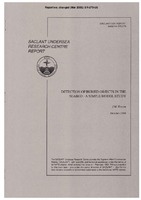| dc.contributor.author | Hovem, Jens M. | |
| dc.date.accessioned | 2018-10-11T14:08:49Z | |
| dc.date.available | 2018-10-11T14:08:49Z | |
| dc.date.issued | 1998/10 | |
| dc.identifier | 12143 | |
| dc.identifier.govdoc | SR-279 | |
| dc.identifier.uri | http://hdl.handle.net/20.500.12489/517 | |
| dc.description.abstract | The problem of detecting an object buried in the seabed is studied by means of a simple model. In this model, the object is a rigid sphere buried in a bottom modelled as a fluid half space. The scattered field is determined for all angles, including grazing angles lower than the critical angle. The analysis shows that the scattered field is considerably changed in amplitude and angular distribution, when the incoming wave is an inhomogeneous wave. There is relatively strong scattering in a broad angle interval, near the vertical direction. The detectability of a buried target is determined by the echo-to-reverberation level. This issue is discussed using a simple bottom reverberation model based | |
| dc.description.abstract | on the small-roughness perturbation approximation. Signal-to-reverberation ratios are computed for different bottom types and for angles lower and higher than critical angle, for monostatic and bistatic detection situations. | |
| dc.format | vi, 22 p. : ill. ; 10 fig. | |
| dc.language | English | |
| dc.publisher | NATO. SACLANTCEN | |
| dc.relation.ispartofseries | ADB247159L | |
| dc.subject | Buried objects detection | |
| dc.subject | Acoustic scattering by elastic structures | |
| dc.title | Detection of buried objects in the seabed: a simple model study | |
| dc.type | Scientific Report (SR) | |
